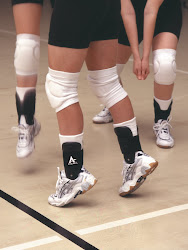Coming off of their recent silver medal in the 2008 Olympic Games in Beijing, the U.S. Women's National Indoor Volleyball Team gears up for another spectacular season-starting with try-outs on February 20-22. As per the teams official website, over 64 colleges were represented in the competition for the team's 33 open roster spots. "USA women's volleyball has such depth and talent, it is wonderful to see this many outstanding young athletes attending this National Team tryout," said head coach Hugh McCutcheon. "I believe playing for the National Team is the highest achievement possible for our indoor players. In that regard, our goal is to create the best environment for these players to train and compete at the international level."
So what does it take to be able to play for the U.S. Women's National Team? Or any national team, for that matter? (Guys, I'm not trying to leave you out here!) When most of these players first stepped out onto the court as high schoolers their biggest concern probably wasn't how they were going to rise to national stardom. For many volleyball was still a new experience, something fun to do with their friends.
As they aged, so did their ambition. College ball is tough, and there's a lot of competition for spots on the team. You don't play at the college level unless you've got what it takes to keep up with some of the best players in the world. At that point you have to make a choice-is volleyball just a hobby, or do you have what it takes to go all the way?
on the team. You don't play at the college level unless you've got what it takes to keep up with some of the best players in the world. At that point you have to make a choice-is volleyball just a hobby, or do you have what it takes to go all the way?
(Photo taken by Bill Kaufman. Located at http://usavolleyball.org/news/article/10001)
Come check out our huge selection of volleyball gear at http://www.volleyballproshop.com/.















